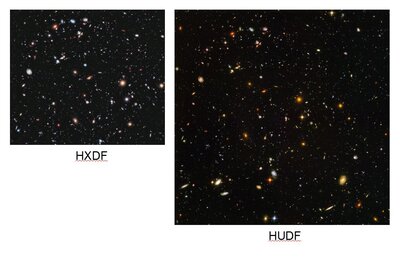by johnnydeep » Wed Aug 04, 2021 1:54 pm
JohnM wrote: ↑Wed Aug 04, 2021 11:47 am
Is the image in fact the Ultra Deep Field or is it the Extreme Deep Field ?
The image looks more like the Extreme Deep Field .
I did not think the UDF had galaxies to a look back of 13.1 gyr as it did not have the Hubble far infrared data that is in the extreme deep field.
Comments ?
John
You seem to be correct, at least with regard to the image. This "UDF" APOD pic matches the image of the XDF at
https://www.nasa.gov/mission_pages/hubb ... e/xdf.html
Called the eXtreme Deep Field, or XDF, the photo was assembled by combining 10 years of NASA Hubble Space Telescope photographs taken of a patch of sky at the center of the original Hubble Ultra Deep Field. The XDF is a small fraction of the angular diameter of the full moon.
The Hubble Ultra Deep Field is an image of a small area of space in the constellation Fornax, created using Hubble Space Telescope data from 2003 and 2004. By collecting faint light over many hours of observation, it revealed thousands of galaxies, both nearby and very distant, making it the deepest image of the universe ever taken at that time.
The new full-color XDF image is even more sensitive, and contains about 5,500 galaxies even within its smaller field of view. The faintest galaxies are one ten-billionth the brightness of what the human eye can see.
Comparing the image at the NASA XDF link with the image at this NASA UDF link (
https://svs.gsfc.nasa.gov/309460) show that the XDF is a (slightly - appears to be about half the area) smaller field of view of the UDF field of view:

- XFD Compared to UDF Fields of View
But, I'm
wrong [ EDIT: actually, mostly right] about the FOV comparison. From
https://en.wikipedia.org/wiki/Hubble_Ul ... Deep_Field
The Hubble eXtreme Deep Field (HXDF), released on September 25, 2012, is an image of a portion of space in the center of the Hubble Ultra Deep Field image. Representing a total of two million seconds (approximately 23 days) of exposure time collected over 10 years, the image covers an area of 2.3 arcminutes by 2 arcminutes,[15] or approximately 80% of the area of the HUDF. This represents approximately one thirty-two millionth of the sky.
The HXDF contains approximately 5,500 galaxies, the oldest of which are seen as they were 13.2 billion years ago.
EDIT: and I found this nice comparison that shows the overlapping FOVs of the XDF and UDF quite well:
[quote=JohnM post_id=315557 time=1628077670]
Is the image in fact the Ultra Deep Field or is it the Extreme Deep Field ?
The image looks more like the Extreme Deep Field .
I did not think the UDF had galaxies to a look back of 13.1 gyr as it did not have the Hubble far infrared data that is in the extreme deep field.
Comments ?
John
[/quote]
You seem to be correct, at least with regard to the image. This "UDF" APOD pic matches the image of the XDF at https://www.nasa.gov/mission_pages/hubble/science/xdf.html
[quote]Called the eXtreme Deep Field, or XDF, the photo was assembled by combining 10 years of NASA Hubble Space Telescope photographs taken of a patch of sky at the center of the original Hubble Ultra Deep Field. The XDF is a small fraction of the angular diameter of the full moon.
The Hubble Ultra Deep Field is an image of a small area of space in the constellation Fornax, created using Hubble Space Telescope data from 2003 and 2004. By collecting faint light over many hours of observation, it revealed thousands of galaxies, both nearby and very distant, making it the deepest image of the universe ever taken at that time.
The new full-color XDF image is even more sensitive, and contains about 5,500 galaxies even within its smaller field of view. The faintest galaxies are one ten-billionth the brightness of what the human eye can see.[/quote]
Comparing the image at the NASA XDF link with the image at this NASA UDF link (https://svs.gsfc.nasa.gov/309460) show that the XDF is a (slightly - appears to be about half the area) smaller field of view of the UDF field of view:
[attachment=0]XDF versus UDF.JPG[/attachment]
But, I'm [s]wrong[/s] [ EDIT: actually, mostly right] about the FOV comparison. From https://en.wikipedia.org/wiki/Hubble_Ultra-Deep_Field#Hubble_eXtreme_Deep_Field
[quote]The Hubble eXtreme Deep Field (HXDF), released on September 25, 2012, is an image of a portion of space in the center of the Hubble Ultra Deep Field image. Representing a total of two million seconds (approximately 23 days) of exposure time collected over 10 years, the image covers an area of 2.3 arcminutes by 2 arcminutes,[15] or approximately 80% of the area of the HUDF. This represents approximately one thirty-two millionth of the sky.
The HXDF contains approximately 5,500 galaxies, the oldest of which are seen as they were 13.2 billion years ago.[/quote]
EDIT: and I found this nice comparison that shows the overlapping FOVs of the XDF and UDF quite well:
[img2]https://www.syfy.com/sites/syfy/files/styles/1170xauto/public/hubble_legacy_field_footprints.jpg[/img2]